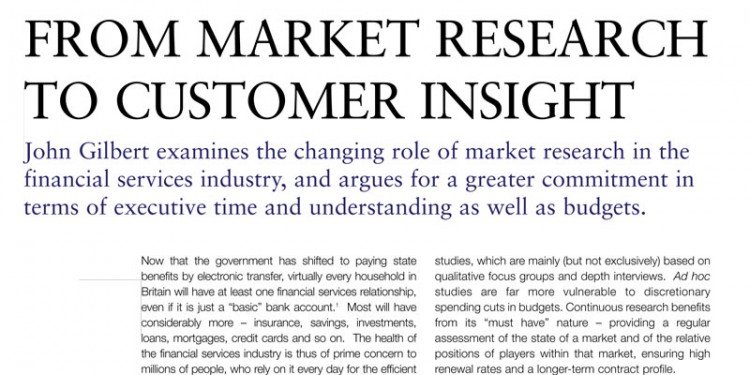John Gilbert examines the changing role of market research in the financial services industry, and argues for a greater commitment in terms of executive time and understanding as well as budgets.
Now that the government has shifted to paying state benefits by electronic transfer, virtually every household in Britain will have at least one financial services relationship, even if it is just a “basic” bank account.1 Most will have considerably more – insurance, savings, investments, loans, mortgages, credit cards and so on. The health of the financial services industry is thus of prime concern to millions of people, who rely on it every day for the efficient management of their money and for processing millions of banking and credit card transactions.
Ensuring industry stability and the fair treatment of all customers are amongst the main objectives of the Financial Services Authority (FSA), whose demand for financial research is steadily increasing as its influence and responsibilities grow.
The numbers involved are huge – the top-ten bank brands alone account for some 110m relationships. Once a customer relationship is established, the institution’s goal is most likely to be to expand that relationship – through either cross-selling other products or services, or up-selling by offering aspirational products that increase the product spend – getting customers to move to a premier bank account or a platinum credit card, for example. In order to achieve sales targets quickly, and reflecting the intense competition for customers, most major institutions have preferred not to undertake more time-consuming market research but, rather, to pour substantial sums of money into advertising and promotional expenditure – more than £1.5 billion3 on advertising alone over the past two years. By comparison, the spend on financial market research was just £68m in 2002, the latest year for which figures are available. The trend in Figure 1 (p32) and the depressed operating environment for the life insurance and investment management market sectors suggests, though, that there will have been little upturn in research spend in 2003.
The primary spilt in market research is between continuous research – mainly quantitative – and ad hoc studies, which are mainly (but not exclusively) based on qualitative focus groups and depth interviews. Ad hoc studies are far more vulnerable to discretionary spending cuts in budgets. Continuous research benefits from its “must have” nature – providing a regular assessment of the state of a market and of the relative positions of players within that market, ensuring high renewal rates and a longer-term contract profile.
To read the full article, please download the PDF above.

